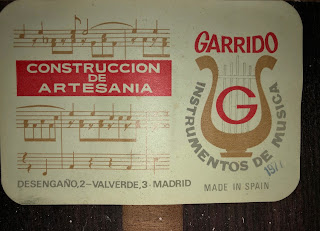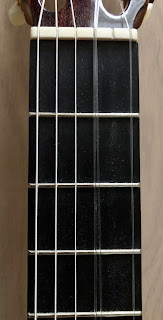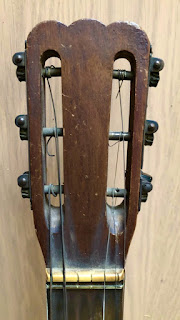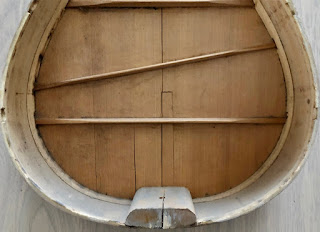Guitar distributed by Casa Garrido in Madrid, Spain,
Garrido worked with several builders from different parts
of Spain, such as Ricardo Sanchís, Juan Estruch, Modesto
Borreguero, Telesforo Julve, among others. It is the history
of Spanish lutherie. This is a solid wood guitar with a good
and authentic Spanish construction. Wood: Solid cedar
soundboard. Sides and back solid rosewood, with long
drying time. The marquetry details are of the time, beautiful.
The sound is vintage, very versatile, you can see the
personality that this builder put in his guitars, very com-
fortable and light to play The condition is good, it shows
hardly signs of use. Scale: 655 mm. Width nut: 53 mm.
It is to be noted that a Vicente Camacho labelled guitar
on the site of Vintage Guitar World has exactly the
same scale. That guitar is also from 1977. Odd thing
is that in both guitars the date has been stamped.
A beautiful rosette but difficult to determine wether
if this is the work of Vicente Camacho as he made
a big variety in rosette designs. The typical bridge
model is exacte the same as a Vicente Camacho
labelled guitar and to name the rather square modelled
detail, can mention the shape of the wood just before
the bridgebone. On most guitars that part is absolutely
more rounded. He only built about 12 guitars a year
has been stated somewhere: I doubt that as there are
also student guitars around with the Camacho label
but it could be possible that he imported these
range of guitars.
A close picture has been taken to not only show the
rather square piece of wood on the left but also the
slanted string tie block on the right: Not parallel
with the soundboard. Another typical feature.
Every picture can probably tell us more about this
high quality guitar, but who was the builder? Anyway,
the cross bar, Vicente Camacho used in his guitars is
present in this guitar as well as the long and flat
horizontal brace under the bridge. Inner woodwork
is of a high quality. Furthermore the soundboard
has been provided with a 5 piece fan bracing.
A cedar topped guitar in the Madrid tradition of that
time, initiated by Jose Ramirez III. This soundboard
really resembles the soundboards used on the 1A
model of Jose Ramirez in that it is narrow grained
and shows medullary rays that gives it a kind of
silky pattern. Though Camacho followed much of
the Madrid school at that time, he didn't use the
665 mm scale that much, used by various other
luthiers in and around Madrid.
WHAT ARE MEDULLARY RAYS?
Often referred to by luthiers as ‘silk’ or silk figure,
medullary rays are cellular structures which in coniferous,
softwood, are easily recognizable on the surface of the
quartersawn face. Luthiers like to see silk in their topwood
as its presence is a guarantee that the wood is well quartered.
It’s possible for well-quartered wood to not show any
medullary rays, but wood with visible medullary rays is
most certainly quartersawn. Silk figure is also very
attractive and is strongly reminiscent of the curl figure
we sometimes see in maple and other woods but on a
much smaller scale. It adds a subtle, three-dimensional
shimmer to a finished top. In different woods, the visual
effect can differ quite a bit, but in the Spruces, Redwood
and Cedar we use in lutherie, the appearance is roughly
the same. We do see it occasionally in some of the
hardwoods such as Mahogany, Sapele and even Ebony.
The patterns show where the trees cellular structure is
aligned to distribute water and other nutrients from the
center of the tree out towards the bark.

Garrido appears to be a retail store brand with the store
in Madrid, Spain. Came across this brand on eBay –
a purported 1960s classical guitar (Brazilian Rosewood)
labelled Garrido with an association with the luthier
Modeste Borreguero. According to Acoustic Guitar Forum
Modeste Borreguero set up his own workshop in 1952 and
worked exclusively for the dealers Casa Garrido in Madrid.
He also taught the now retired maker Vicente Perez Camacho
(b.1928). Borreguero (b.ca.1893 in Madrid) retired from
guitar making in 1963 and he died in 1969. How things
were combined at that time, I do not know but they
seemed to work on the same address.
Garrido Classical guitars have a long tradition of construction
in Spain, and the first units in 1953 soon became a quality
standard within its mid-range guitar segment. Nowadays, Garrido
guitars have construction and sound at the best price. See:
Desengano 2 - Valverde 3 are both in a way mentioned
to be the workshop of Modeste Borreguero. Both Vicente
Camaro as Modeste Borreguero sold their guitars to the
Garrido music shop in Madrid. The second label showed
here is a very early "Casa Garrido" guitar built by
Modeste Borreguero in 1953.
Nicely shaped head with a topnut that is fine tuned.
The headform definitely points towards Vicente
Camacho as a luthier. Also the rather wide sleeves
can be considered a Camacho trademark as is the
rather flat inner tongue among others.
No damage on the top of the head which often
occurs when placing a guitar against a wall.
This guitar must have been stored by a collector as
there are hardy any traces of normal use on this guitar.
Therefore the frets are still in a like new condition.
The wood remains a bit questionable to me as it has an
orangy character here and there that reminds me of Brasilian
rosewood. The cedar top anyway can be compared with the
first grade quality Jose Ramirez III uses on his 1A concert
instrument. Very fine grained. and last but not least: Its
sound that is really beautiful with strong trebles but
rounded on the sweet spot of this guitar. Lots of volume
and this guitar colors nicely once striked at different
spots. Immediately comparable to my 1981 Jose
Ramirez Clase 1A, both equipped with the typical
Madrid sound but simply different from each other.
The string tie block that was already "slanted" made
by Modeste Borreguero. As a pupil, Vicente Camacho
kept that idea from Borreguero as can be seen in
the picture here beyond. Probably encouraged by his
master, Modeste Borreguero Camacho also worked for
Hernandez y Aguado in the 60ies of the past century
from time to time? (thanks to Mister Hogenmueller)
General information about Vicente Perez Camacho:
Vicente Perez Camacho was born in Madrid in 1928.
Like so many guitar makers of his epoch he apprenticed
first as a cabinet maker, beginning his working life
when he was eleven. In 1952, he decided to apprentice
with Modest Borreguero (1901-1969, one of the famous
guitar makers to come out of the Manuel Ramirez
workshop, who he had known since 1943. Vicente worked
in Borreguero's small workshop on the Calle Desengano
No 3 until he decided to open his own workshop in 1959
on Amparo No 3. During the 1960s Vicente sold his guitars,
as did Borreguero for some years, through Garrido, one
of the major music stores in Madrid for many years.
Vicente retired in 1992. This could be one of those sold
through Garrido. It bears the stamped Casa Garrido label.
There are not any cracks repairs or issues. The guitar
still has its' original lacquering: the finish is
flawless. Mechanical tuners (probably Fustero's)
appear to be original.
Regarding Flamenco guitars
A choice of maple is not as unusal for flamenco as it might
appear. Until the 1930s, maple was the top choice for a fine
flamenco guitar, and only fell out of favor because during
the depression, few could afford it and local cypress was
much cheaper. There are not any cracks repairs or issues.
The guitar still has its' original lacquering: the finish is
flawless. Mechanical tuners (probably Fustero's) appear
to be original.
A post by someone who owns a Vicente Camacho guitar.
Actually I do have a V. Camacho made in 1975, cedar top, Indian rosewood
back and sides. A very nice guitar, 66 cm, rather light (much lighter than the
Ramirez 1a of this time, and also less weight than most other guitars that
I know - except for some flamencas). The 5 fan-style braces look quite
usual, with a long and flat horizontal brace under the bridge, but a diagonal
asymmetric harmonic bar (less diagonal than in the Ramirez), starting and
ending at ribs. The head shape is quite special (like Santos but with a
"Ramirez" tip in the middle), and the rosette (individual, never seen another
one exactly like this) has the Madrid colours (red, green and black wood)
and it is repeated on the bridge. The label is dated, signed and stamped,
and the sound board is stamped again on the inside close to the bridge.
Clearly individual work, and the man was proud of his product.
Concerning the sound, it is suprisingly loud, but lighter and clearer trebles
than the Ramirez of this time that I know. Lots of overtones, beautiful
harmonics, well balanced, especially the basses are not too loud, but present.
I cannot compare with any other guitar that I have. Also, it is easy to play,
because of the nice neck (width 52 mm at the nut).
This is indeed one of my favourite instruments.
Vicente Camacho designed a cross-braced system for the
guitar top that produces a loud and clear tone even in small
body guitar. The tone is well balanced and projects really
well. If you have heard El Trio Los Panchos, you will recognize
the sound. Camacho’s guitars are also famous because they
were one of a kind piece of art. Every single part was made
by the luthier, except the machine heads. His rosettes looked
similar to each other but were different. The design matches
the bridge. None of his guitars is equal to another. He made
small scale guitars by demand. He used spruce, cedar, Indian
and Brazilian rosewood mainly. Among his collectors are
Angel Romero, Peter Capell, Emma Martinez, Greg Lake,
Pepe Vergara and Ramon Villar. Camacho was very well known
in London, where his guitars were sold by the London Guitar
Studio. An interview with Vicente Camacho was published by
Classical Guitar Magazine in July 1986. Some of his guitars have
Garrido brand on the sound hole label (circa 1960s) as he
sold his guitars for many years through this Madrid store.
From the Zavaletas Site:
In 1952, Borreguero moved his workshop to
Desengaño No 4, and began to build exclusively
for the music store Casa Garrido. There he also
took on the training of Vicente Perez Camacho,
who went on to become a noted luthier. He also
taught a young Felix Manzanero how to French
polish, a skill that allowed Manzanero to enter
Jose Ramirez III workshop as an apprentice.
VICENTE CAMACHO
Vicente Pérez Camacho nació en Madrid en 1928. Como tantos guitarreros de su época, primero aprendió cómo ebanista, comenzando su vida laboral a los once años. En 1952 comienza como aprendiz de Modesto Borreguero.
Vicente trabajaba en el pequeño taller de Borreguero en la calle Desengaño Nº 3 hasta que decidió abrir su propio taller en 1959 en el Amparo nº 3.
Durante los años 60 Vicente vendió sus guitarras, al igual que Borreguero durante algunos años, a través de Garrido, una de las tiendas de música más importantes de Madrid. Vicente se jubila en 1992.
Translation:
VICENTE CAMACHO
Vicente Pérez Camacho was born in Madrid in 1928. Like so many guitar players of his time, he first learned how to become a cabinet maker, beginning his working life at the age of eleven. In 1952 he began as an apprentice of Modesto Borreguero.
Vicente worked in the small Borreguero workshop at 3 Desengaño street until he decided to open his own workshop in 1959 at 3 Amparo.
During the 1960s Vicente sold his guitars, like Borreguero for some years, through Garrido, one of the most important music stores in Madrid. Vincent retired in 1992.
The guitar in France:
They all came with their Spanish guitars and the first Ignacio Fleta guitars showed up in Paris in 1955 in the hands of Sierra and Cueto. They were immediately greatly admired and gradually caused the guitars of Torres, Manuel Ramirez, Esteso, Simplicio, Garcia, etc. to be put back in their cases.
Other makers, such as Conde Hermanos, Mateu, Vicente Camacho, Arcangel Fernandez and De la Chica, found a place on the French market where they sold hundreds of their instruments.
Presented here is a German Parlor guitar with its'
neck loose from the body so no one was interested
in it. There were many of these guitars made in
Germany around 1900 but this one showed some nice
woods e.g. rosewood sides and back and a narrow
grained top and for less than 100 Euro's you can
give it a try.
In fact I was further in the process here as at first it
was my goal to release the neck from the body that
had some give when moving forth and backwards.
Injecting water in the glue surfaces after having
removed the fingerboard from the twelfth fret on
made it possible to do so.
The lacquer used on a lot of these factory produced instruments
is quite heavy and that is resulting in white traces once damaged.
That was the case on the whole instrument so a lacquer remover
was the next step.
It has lasted quite while since the paint companies did overcome
the problems with a new process for making lacquer remover as
some ingredients were no longer allowed. The newer versions
are working again as can be seen here.
A close up from the spot where the neck had some play.
Maybe not visible in this picture but this bridge was cracked
and the black painted wood is a bit of a cheap move on an
otherwise very decent instrument.
On this picture one can see I made a new bridge out of
Madagascar rosewood, one of those woods that
sometimes do resemble Brazilian rosewood a bit.
I made this shot for investigators on wood as I found the same
quality and sort of rosewood on a very nice guitar, most likely
made by Edgar Monch, a bit a forgotten luthier that moved for
a while to Canada and it is known that he produced guitars
for the local music shops in Germany later on.
Regluing and outlining the fingerboard is a next step but
after the frets have been (re)placed. Leveling the two
parts of this fingerboard is hardly necessary when you
try to get as close as possible before replacing the outer
end of the fretboard. A kind of a herringbone inlay
around the sound hole and at the edges German luthiers
are known for. Germany exported these strips before
world war II to factories like Martin but stopped during
the war and afterwards.
Then the relaquering of the front and apart from that:
Sides and back though I switch continuously as you
need more than one layer. About 8 thin layers give a
good result and of course polishing between every
layer. The neck hasn't been refinished up until now.
The typical thing that I also discovered on other German
parlor guitars is that the back often has been made out of
one piece of wood. The Germans have always been good
woodworkers and chances are that they treated the outside
only to make it look like rosewood but not in this case.
The herringbone inlays can be studied here as they often
did this with these guitars.
The newly made bridge that has a piece of fretwork mounted.
It is obvious that the angle neck / body has to be perfect here.
A nice shot of this beautiful piece of wood.
On this picture you can try to find any seam.
The extended fingerboard but only partly for the higher notes.
D. Julian Gomez Ramirez ( 1879 - 1943 )
This instrument has been provided with a very strange plantilla.
It is known of course that luthiers used to experiment more than
in these times but Gomez Ramirez may also have built this
instrument on special request in 1917. We simply don't know.
Later investigations learned that Sinier de Ridder once had an
identical example! So this is not a one of a kind.
Also the headform differs from his other instruments. Thoughts
may arise that it could be an instrument from another builder but
the soundboard has been signed by Don Julio Gomez Ramirez
himself. Also the label seems to belong there and was there from
the beginning. Inner linings to not appear to be added in a later
stage so conclusions can be that this was intended the way it is.
Provided with EON tuners from French origin but this guitar
could have been originally built with tuning pegs in order for
more lightness. Wether if this instrument really was intended
as a flamenco guitar remains the question. Cedar neck with
ebony fingerboard and Brasilian rosewood back and sides.
As it is not the case with a lot of instruments known from
this luthier, this guitar has been built with Brasilian rosewood.
Its' scale is 655 mm. The condition is quite good regarding
the number of cracks, neck angle and playability etc.
The back has two insert for former cracks, both in the left
part of the back. This guitar is quite deep in comparison
to other instruments of that time. Therefore the basses are
sounding rich and deep. The balance is good and the higher
notes have a sweet voice though I expect this guitar once
played for a longer time will open itself even more.
Remarkable tone separation and a sweet immediately
recognizable voice.
As you might expect a bookmatched back of course.
Bone or maybe even an ivory scratchplate. The inlay in
the soundboard has been done securely and can be studied
in the mid of the lower part of this picture. multiple layers
on the edge of its' soundboard.
By clicking on this picture you are able to study the edge
inlay. Carefully done as can be expected from a top luthier.
Most likely intended as a more luxury instrument as most
of the time the rosette on his guitars exist of concentric
circles. The fingerboard seems to have been shaved and
a later added layer of ebony has been glued onto the
further original neck.
Don Julio Gomez Ramirez didn't made that much elaborate
rosettes on his guitars and had to make a living sometimes
with the building of cheaper models. The inner workmanship
on this guitar is immaculate and special attention can be
asked for the strutting of the soundboard which is quite
extraordinary! I will come up with some pictures.
The silver inlay on the string tie block is another sign of
the expensiveness this instrument must have had.
Not that elaborate but anyway: More than concentric circles
alone. The label is still in great shape though the ink with
which he dated, numbered and signed this guitar, has fainted.
Brasilian rosewood, allways nice to look at! This guitar
is probably veneered but that also explains why sides
and back are still in a good condition. The inner layer
of wood appears mahogany to my idea. In fact, a
lot of historic luthiers did this to achieve a sweeter
tone and moreover chances that cracks might
occur are diminished in this way.
The label has been photograhed allready and that is
telling that this instrument was constructed especially
for Vincent de .........Possible instrument number 204
made in 1917 both written at the bottom. In between
Julian Gomez Ramirez placed his signature. You
can enlarge it by clicking on this picture.
This picture and the following ones are from about the same
model Sinier de Ridder once had. The endblock has been
stamped on this one which is not the case in my guitar.
The same shorter head but no zero fret and according
to me the bridge mounted here is a later addition.
To make the fan bracing even longer Gomez Ramirez
made a kind of tunnel which he also did in my guitar.
Robert Bouchet lent this idea from his great inspirator,
Julian Gomez Ramirez and in that way putted the
French lutherie regarding guitars "on the map".













































































Geen opmerkingen:
Een reactie posten